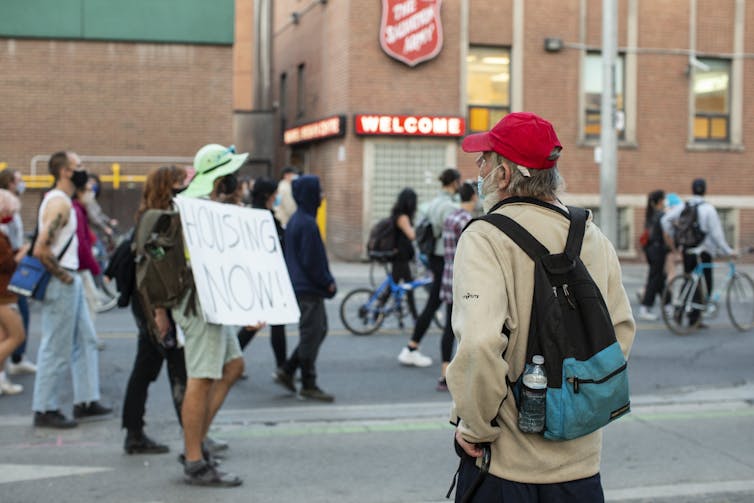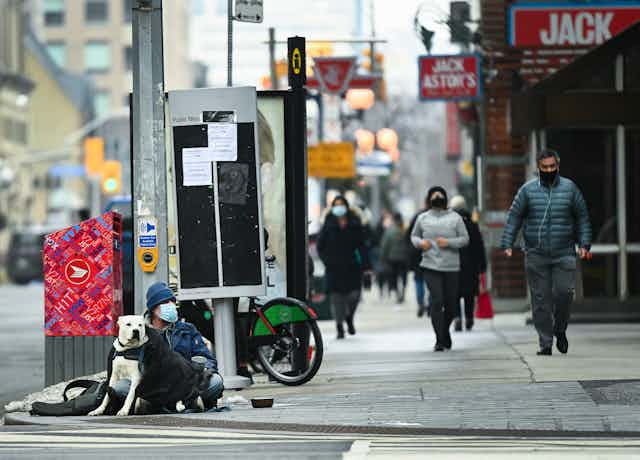COVID-19 outbreaks in shelters and other effects of the virus forced more people to sleep rough — on sidewalks, under bridges, in encampments — making homelessness more visible. People experiencing homelessness were disproportionately impacted and five times more likely to die of COVID-19.
Stephen Gaetz, director of the Canadian Observatory on Homelessness, asks “What if we managed the pandemic like we treat homelessness?” What if only the symptoms of COVID-19 were managed? What if, instead of masks, social distancing and vaccines, the only measure would be to treat sick people who come to an emergency room? The result: many more would die.
This approach would cause an outcry, but when it comes to homelessness, addressing only the symptoms has been the norm. Once people are living in shelters, they have reached the “emergency room” of a system that has not done enough to prevent them from getting there.
The solutions to homelessness are not unknown or out of reach. There are many programs and organizations creating solutions that are part of a systems-based strategy to help end homelessness in Canada. Research clearly points to three important measures: affordable housing, support programs and prevention.
As a social innovation designer, my research, teaching and practice focus on systems thinking and understanding and designing socially innovative solutions that don’t simply address the symptoms — they also get to the root of the challenge. I try to share my research through accessible means which led me to create, produce and host my own podcast series. The most recent episode of the podcast looks at homelessness and housing as a right.
Affordable housing
Demand far exceeds supply for affordable housing. A shift in the role government plays in Canada and a decades-long lack of investment in housing has led to the levels of homelessness we are seeing.
And low incomes are contributing to the problem. The Ontario Disability Support Program provides a housing allowance of $497 per month. Ontario Works, the social assistance program, provides $390 a month. As of November 2021, the minimum wage in Ontario is $14.35 an hour or about $1,955 a month after taxes. In Toronto, the average cost of a studio apartment is $1,211, and $1,431 for a one-bedroom apartment. It’s clear: the math doesn’t work.
Toronto has a centralized waiting list for subsidized housing, this list currently has over 78,000 names and an estimated wait time of 12 years or more for a one-bedroom unit.

Support programs
For decades the prevailing policy was that people needed to be “housing ready” before being placed in permanent housing, which meant being clean and sober, and in counselling and treatment for mental health. Many practitioners working on the ground observed that this approach just didn’t work.
Sam Tsemberis, a Canadian psychologist working in New York City in the 1990s, gathered a group of outreach workers and asked: What if we got people in permanent housing first and then worked with them to get the services they need?
This was the foundation for Housing First, “a rights-based intervention rooted in the philosophy that all people deserve housing, and that adequate housing is a precondition for recovery.” Housing First programs provide the services that help people stay housed and where they can thrive.
In 2008, the federal government launched a four-year research demonstration project of Housing First called At Home/Chez Soi. Years of data gathering and analysis of the outcomes proved the effectiveness of the program which has been integral to the design and implementation of several innovative initiatives across Canada. The approach works, but it needs to be properly funded.
Prevention
Once people are housed, many need support to stay housed. Some communities provide resources and small loans to assist with rent, as well as legal aid to help stave off evictions.
People exiting systems like criminal justice, hospitals and child protection are vulnerable to experiencing homelessness. This can be prevented by ensuring they have help with transitioning into appropriate housing.
Another critical area for prevention is youth homelessness. Over one-third of adults experiencing homelessness report first being homeless in their youth. A Way Home Canada sees youth homelessness as key to ending all homelessness in Canada. It has demonstration projects in three Canadian cities built on a Housing First for Youth framework.
Investing in an end to homelessness
Ending homelessness requires a shift away from the belief that one program or intervention will solve homelessness to a shared understanding that interconnected systemic factors must be addressed.

We need governments to heavily invest in affordable housing while also regulating the housing market. We need funding of essential support services that will help individuals quickly access safe, affordable housing and be able to remain there. We need funding to help prevent homelessness, including eviction and transitional supports and a focus on preventing youth homelessness.
The money to pay for this is already there. Much of it is spent dealing with the consequences of homelessness. There is tremendous opportunity to refocus resources from managing the symptoms to preventing homelessness.
Research scientist Eric Latimer and his team at McGill University calculated the costs of services for homeless people with mental illness in five Canadian cities, including expenses related to hospital visits, court appearances and other services. The team determined that annual costs averaged $59,000 per person in Canada’s three largest cities. For 10 per cent of those studied, costs exceeded more than $93,000.
This is one data point in a sea of budgeted and societal costs of homelessness adding up to billions of dollars spent. And yet people remain unhoused, with as many as 235,000 people in Canada experiencing homelessness in any given year. How can we afford not to invest in a different approach?
Ways forward
What if we treated homelessness like a pandemic? We would invest in preventing it and ensure that those who are unhoused have timely access to affordable housing and the support services they need to stay housed.
If we are to learn anything from the COVID-19 pandemic, it is that prevention is key and homelessness is not something we can continue to ignore by pushing it out of sight. COVID-19 can be a reset, a catalyst to invest and double down on creating a society without homelessness.
We need a nationwide, fully resourced effort. We can help end homelessness by choosing to shift our individual and collective focus to support affordable housing, support services and prevention through voting, public funding and opening our minds and hearts.

